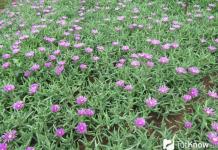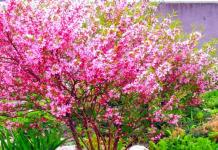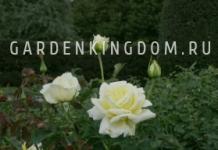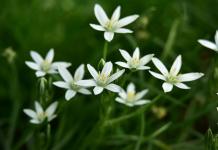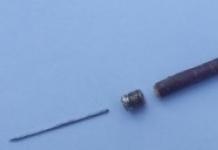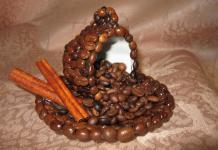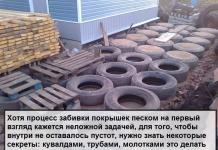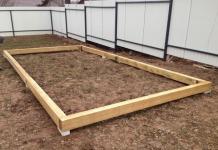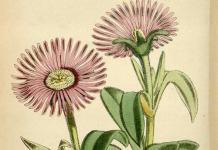LATIN NAME: ORNITHOGALUM
Bulbous crops allow you to get the earliest and most lush flowering in your backyard, but a lot depends on the selection of varieties and species. We offer you to get acquainted with a lovely flower, not very common in our country.
Far from the most spectacular primroses, but very neat and beautiful - this is the ornithogalum (ornithogalum), an extensive genus of the Asparagus family, the Hyacinth subfamily. Numerous species are distributed throughout the world. Many of them are found in the northern and southern parts of the African mainland. Some are distributed wild in regions of Eurasia. Perennial grows well in temperate and subtropical climates, characteristic of North and South America, as well as for some parts of Russia. In the USSR, many species were listed in the Red Book as endangered.
The tailed or Indian onion flowers are suitable for growing at home, where flowering continues for almost all 12 months without interruption. However, more often they are planted for landscaping the area adjacent to a country house. This is a beautiful primrose, giving abundant budding immediately after the convergence of a permanent snow cover.
Botanical description
In sources with a botanical description of the plant, another name for the ornithogalum is found - the birdman. The scientific name comes from two Latin words, they have a literal translation: "bird's milk". These are bulbous perennials, some of them are evergreen.
The root bulb is oval, oblong-ovoid or egg-shaped. It is covered with dense white scales. They completely cover the surface of the tuber. The diameter of the bulb is from 2 to 5 cm. The peculiarity of the tuber is that its roots do not die off, but are simply replaced with new ones over time.
Basal leaves are lily-shaped, similar to belts. They appear much earlier than flower stalks. In some species, leaves appear only in autumn, hibernate and die before flowering. The central vein of the leaf plate is grooved, white.
During the flowering period, beautiful bell-shaped flowers are formed, collected in loose thyroid or racemose inflorescences. In some species, it has a thin light green stripe on the middle part of the perianth petal. The inflorescences are apical, most often do not exude aroma. After flowering, the ornithogalum forms a fruit like a box. It contains small black seeds, rounded in shape. 
Planting and caring for a poultry farmer in the open field
3 types are suitable for growing in garden plots:
- birdman of the Balance Ornithogalum balansae,
- umbrella bird Ornithogalum umbellatum,
- drooping poultry bird Ornithogalum nutans.
All of them tolerate frost well and do not require shelter for the winter. Green, narrow leaves, collected in a rosette, appear early, but flowering occurs much later - in May, ornithogalum curtains are covered with many snow-white stars. Flowers close in the evening or on cloudy days. The aerial part dies off by mid-summer.
The bird breeder prefers bright light, but grows well in the shade, only slightly stretching upwards. Feels great under the translucent crowns of trees.
- The soil can be infertile, sandy and loamy.
- When planting, avoid places with stagnant water, which leads to rotting of the bulbs, or lay stones, rubble or broken bricks on the bottom of the planting holes to drain excess moisture.
You should not get carried away with top dressing - the root system of the plant is strong enough and able to receive nutrition on its own. When “overfeeding”, the birdman can “fatten”: form a large number of leaves to the detriment of flowering. You can apply mulching of the soil around plantings with organic humus, this will keep moisture from evaporation and provide additional nutrition that will flow to the roots for a long time.

Poultry farmers overwinter in the middle lane without shelter. In more northern areas, you can use shelter with spruce branches or moss. Often it is enough just ordinary hilling.
The poultry farmer does not require digging: it grows in one place for at least 5 years. Bulbs form many children, as a result, an extensive curtain is formed, which should be divided into separate bulbs when transplanted. And if this is not necessary, then the transplant can be postponed until the flower stops forming flower stalks. This will happen not earlier than in 8 years. Ornithogalum reproduces by babies and seeds. Children can be separated when the green part of the plant dries up and planted.
Reproduction of the birdman
It has already been said that such a flower can be propagated both by children and by a generative (seed) method. It should be remembered that the seeds need stratification, which should last 3 or 4 months, in connection with this they are sown in open soil before winter in prepared grooves of shallow depth. Seedlings should appear in the spring. If there is a desire, then the birdman can be grown through seedlings. Sowing seedlings should be done in early spring. To do this, you can use plastic glasses or a container. To fill the container, use light and loose soil. After 3 or 4 true leaf plates appear, you need to start hardening the seedlings. To do this, for 16-18 days they need to be taken out to fresh air every day, while the time spent on the street should be increased gradually. Landing is carried out only when the plant can be in the fresh air around the clock.
After flowering
After the leaves are completely withered, they will need to be cut off. In mid-latitudes and southern regions, the plant does not need shelter for the winter. However, if the winter period is not snowy and rather frosty, then the area where the ornithogalum grows should be covered with spruce branches. If you grow heat-loving species, which include the dubious birdman and the Arabian birdman, then the bulbs must be dug up in the autumn and planted in flower pots or removed for the winter in the cellar. They are planted in the garden in the spring.
Properties of the birdman
Ornithogalum has a wound healing, analgesic and antimicrobial effect. With the help of this plant, bruises and wounds are treated, inflammation and pain in the joints are eliminated, the body is cleansed of salt, pain in the head is treated, and it is also used for edema. If such a flower is grown at home, then it will purify the air in the apartment, since it contains a large amount of phytoncides.
It should be taken into account that only the crested birdman, also called the Indian onion, has healing properties. Absolutely all parts of this plant are medicinal, including flowers and bulbs. At the same time, such properties do not appear immediately, but only in the second year of life. 
Pests and diseases of ornithogalum
Sometimes the ornithogalum can suffer from the attack of pests - ticks or aphids. In this case, flower beds are treated with insecticides. Or preventive use of deterrent measures. You can successfully use the infusion of tomato leaves or garlic with the addition of laundry soap. Plantings are irrigated with this solution every week.
A good result gives placement near nasturtiums or marigolds. Both of these flowers perfectly repel insects with the smell of their leaves of many insects. If you place these plants around the perimeter of the site, the pests will be confused and will not encroach on more valuable specimens. These methods are quite effective, and besides, they do not poison the environment and do not harm people. Ecological farming is of great importance in our age, saturated with various chemicals that adversely affect health. And the use of the plants themselves to protect against pests is one of the methods of such farming.
Bird farmer in landscape design
Caring for a birdman does not cause much trouble - even a novice florist can handle it - an unpretentious plant will surely please its owner with a scattering of unusual stars among emerald foliage.
- Usually, the flowering of the birdman occurs at a time when other flowers are already resting or are just gaining strength. Therefore, the birdman fills the gaps between the flowering of other plants, which can be successfully used to create a flower bed of continuous flowering.
- Do not forget that the vegetative part of it dies off in the second half of summer, so planting annual flowers that fill the vacated space in the immediate vicinity will hide this drawback and have a positive effect on the general appearance of the flower garden.
- Ornithogalum is usually used for the foreground of mixborders, group plantings along paths.
- Due to its high shade tolerance, it can grow under the crown of large trees and shrubs.
- Perfectly harmonize with muscari, irises, hyacinths.
- The curtains of the bird-man on emerald lawns look great, creating snow-white “clouds” over a plain surface during the flowering period.
According to the theory of Feng Shui, such a plant promotes career growth, patronizes in business and labor success. Helps harmoniously build respectful relationships between children and their parents, improving relationships with adolescents. Symbolizes prosperity in the house. Attracts positive energy, cleanses the environment from negative impacts.
Many of us strive to get capricious exotics that surprise with parrot colors and lush flowering, and after suffering for more than one year with such a specimen, they are disappointed. The poultry farmer will not disappoint anyone, because with minimal care and attention, it will bloom again and again, delighting its owner.
This unusual plant will create a harmonious environment on the site, help to gain health and peace of mind, strengthen the family and delight the household with unforgettable moments during flowering. Once you turn your attention to the birdman, you will never give it up. 
Ornithogalum at home Planting and care
Cups of milky white flowers adorn the windows with the arrival of spring. They have a strong and delicate aroma. Ornithogalum is easy to care for and undemanding.
Any soil that is not too acidic is suitable for a poultry farmer grown on a windowsill. The plant is drought tolerant and does not tolerate excessive watering. Leaves should not be sprayed: accumulated dust is removed with a damp cloth. Under normal conditions, the birdman never sheds leaves, and with good care, it blooms in the spring months every year.
- They plant the birdman so that the bulb is on the surface of the earth, only slightly deepening its bottom.
- Use narrow deep pots. From the bulb to the edge of the pot - 2-3 cm.
- You can plant several bulbs at once side by side, the ornithogalum calmly tolerates dense plantings.
It is transplanted as the bulb grows and the volume of the container is filled with growing fry. The size of the pot should be 5 cm larger than its diameter. Children are separated from the mother plant during transplantation and planted in separate pots. They must be carefully separated and can be immediately, without roots, placed in individual pots in moist soil. They are just pushed into the ground a little. After two weeks, the young bulbs will sprout roots and be able to develop on their own. The poultry farmer has good fertility, its root bulb constantly gives an increase in small baby bulbs. An adult bulb has powerful white roots and lives for a very long time - more than 25 years. It rises more than half above ground level. From it grow flat drooping leaves, which are folded at the end into a tube. The ends of the leaves gradually dry out, and the base continues to grow.
- The presence of good drainage is necessary, waterlogging has a detrimental effect on the bulbs.
- Feeding is useful, but the birdman feels great without them.
- You can apply mineral fertilizers during the active growing season every 2 weeks.
- Usually, the ground before planting is well pre-filled with organic matter, so top dressing is used only on poor soil.
The only thing he really needs is bright light, which contributes to abundant flowering. For the summer, you can take the container with the ornithogalum to the balcony or loggia. You can also plant the bulb for the summer in the garden, not forgetting to dig it out before the cold snap. During this time, the onion will grow significantly and get stronger, having gained strength in the fresh air, it will significantly increase in size. 
Of the pests on the home poultry farm aphids, spider mites, scale insects settle, which can be dealt with with the help of appropriate insecticides. In order not to use chemicals at home, you can apply three times spraying with tar water with an interval of 5 days. To do this, birch tar from a pharmacy is mixed with water (1:10), insisted for a day, shaking occasionally. A stock solution is obtained - it can be stored in a dark place in a sealed container and used as needed. 1 tablespoon of the resulting liquid is added to a liter of water and the plant is sprayed. The rest of the resulting mixture can be poured into a pot to destroy the larvae and eggs hiding in the ground.
Indian onions can be compared with plants such as aloe, kalanchoe. As a family doctor, it will come to the aid of any member of the family. One has only to take into account that all parts of the plant are relatively poisonous and must be handled with care. This treatment is used only externally, and consult a doctor before use, because in some people it can cause allergies.
With numerous useful properties, one should not forget that the birdman is an ornamental plant and attracts the attention of flower growers, many of whom consider it the pride of the collection, planting it on their windows with great pleasure.
The birdman or Ornithogalum (Ornithogalum) is also called the Indian, Mongolian onion, although this wonderful plant has nothing to do with onions or Mongolia. The birdman can become the highlight of any flower garden, taking the baton of flowering from primroses. The plant takes its name from the combination of two Greek words: ornnitho and gala, which means bird's milk.
The plant has been known since ancient times, in culture since the 16th century. Natural habitat - Mediterranean, western Asia, southern Africa and America, Eurasia. Ornithogalum was mentioned in the annals from the time of the campaigns of the Roman legionnaires. Ancient people used the bulbs of the birdman for food. For a long time it was considered a symbol of the birth of Jesus, having received the name of the Star of Bethlehem for this. It is also called the "flower of life" - aromatherapists have long used it to relieve stress and gain peace of mind.
Description of the birdman ornithogalum
Perennial bulbous plant Ornithogalum of the lily family. The stem is absent, the leaves are long, belt-like, dark green in color, appearing before the peduncles. The flowers are light yellow or white with a green stripe on the outer side of the perianth, collected in corymbose or racemose inflorescences of varying density at the top of the peduncle.
A characteristic feature of the bird-man is six-petalled flowers, on the back of each of them a green strip is drawn. The bulb is covered with white papery scales. Baby bulbs are very fond of climbing up juicy scales and often find themselves above the ground. Thanks to numerous children, the plant propagates easily.
Ornithogalum is considered an exotic flower, successfully used by florists to create bouquets and compositions. The poultry farmer has frost-resistant species suitable for home gardens in central Russia. There are several species that cannot tolerate frosty winters and are only suitable for indoor floriculture. Species of the birdman differ in the shape and size of the peduncle, the color of the flowers.
When purchasing bulbs, you should pay attention to the condition of the covering scales and the bottom. The presence of stains and mold indicates a disease. The bulb must be dry and clean, without signs of mechanical damage. On the bottom, the presence of rudiments of roots is welcome. If there are dry roots - this is better not to buy. Before planting, place the bulb in a hydrogen peroxide solution (1 teaspoon per liter of water) - this will disinfect the planting material, and active oxygen stimulates awakening and rapid growth.
Planting and caring for a poultry farmer in the open field

3 types are suitable for growing in garden plots:
- birdman of the Balance Ornithogalum balansae,
- umbrella bird Ornithogalum umbellatum,
- drooping poultry bird Ornithogalum nutans.
All of them tolerate well and do not require shelter for the winter. Green, narrow leaves, collected in a rosette, appear early, but flowering occurs much later - in May, ornithogalum curtains are covered with many snow-white stars. Flowers close in the evening or on cloudy days. The aerial part dies off by mid-summer.
The bird breeder prefers bright light, but grows well in the shade, only slightly stretching upwards. Feels great under the translucent crowns of trees.
- The soil can be infertile, sandy and loamy.
- When planting, avoid places with stagnant water, which leads to rotting of the bulbs, or lay stones, rubble or broken bricks on the bottom of the planting holes to drain excess moisture.
You should not get carried away with top dressing - the root system of the plant is strong enough and able to receive nutrition on its own. When “overfeeding”, the birdman can “fatten”: form a large number of leaves to the detriment of flowering. You can apply mulching of the soil around plantings with organic humus, this will keep moisture from evaporation and provide additional nutrition that will flow to the roots for a long time.

- Poultry farmers are planted in groups to a depth equal to three diameters. If you dig up an ornithogalum for the winter, you can plant it shallowly, at half the height of the bulb.
- Each planted onion grows well after a couple of years, forming a dense bush, and with a very strong thickening it stops blooming.
- Ornithogalum is planted at the end of summer at a distance of 15 cm in fertile loose soil. Before the onset of stable cold weather, the bulbs will take root, and in the spring they will start to grow and bloom.
Poultry farmers overwinter in the middle lane without shelter. In more northern areas, you can use shelter with spruce branches or moss. Often it is enough just ordinary hilling.

Ornithogalum also reproduces by seeds. Children can be separated when the green part of the plant dries up and planted.
The poultry farmer does not require digging: it grows in one place for at least 5 years. Bulbs form many children, as a result, an extensive curtain is formed, which should be divided into separate bulbs when transplanted. And if this is not necessary, then the transplant can be postponed until the flower stops forming flower stalks. This will happen not earlier than in 8 years.
Poultry farmer from seeds

Poultry seeds are best sown before winter for natural stratification.
If you decide to grow ornithogalum seedlings:
- Place the bowl with the sown seeds for a month in the refrigerator or under the snow. Seeds must be fresh, because they quickly lose their germination.
- The sowing container must have drainage holes in the bottom.
- The substrate for planting can be used ready-made, for flowering plants.

- A month later, after undergoing stratification, place the container in sunlight, covering it with plastic wrap or glass. The seeds will not germinate at the same time.

- Try to initially sow the birdman as little as possible to avoid subsequent dives (at least 5 cm apart). You can immediately place 1 seed in separate cups.
- Polyethylene is removed every day for airing for several minutes, gradually increasing the time.
- Water little by little, as the substrate dries.
- Young seedlings can develop in this dish without a transplant until they grow up, and then they can be planted in a permanent place.
- Plants will bloom with good care in 5 - 6 years.
Pests and diseases of ornithogalum
Sometimes the ornithogalum can suffer from the attack of pests - ticks or aphids. In this case, flower beds are treated with insecticides. Or preventive use of deterrent measures. You can successfully use the infusion of tomato leaves or garlic with the addition of laundry soap. Plantings are irrigated with this solution every week.
A good result is given by placement near nasturtiums or. Both of these flowers perfectly repel insects with the smell of their leaves of many insects. If you place these plants around the perimeter of the site, the pests will be confused and will not encroach on more valuable specimens. These methods are quite effective, and besides, they do not poison the environment and do not harm people. Ecological farming is of great importance in our age, saturated with various chemicals that adversely affect health. And the use of the plants themselves to protect against pests is one of the methods of such farming.
Bird farmer in landscape design

Caring for a birdman does not cause much trouble - even a novice florist can handle it - an unpretentious plant will surely please its owner with a scattering of unusual stars among emerald foliage.
- Usually, the flowering of the birdman occurs at a time when other flowers are already resting or are just gaining strength. Therefore, the birdman fills the gaps between the flowering of other plants, which can be successfully used to create a flower bed of continuous flowering.
- Do not forget that the vegetative part of it dies off in the second half of summer, so planting annual flowers that fill the vacated space in the immediate vicinity will hide this drawback and have a positive effect on the general appearance of the flower garden.

- Ornithogalum is usually used for the foreground of mixborders, group plantings along paths.
- Due to its high shade tolerance, it can grow under the crown of large trees and shrubs.
- Perfectly harmonize with muscari, irises, hyacinths.
- The curtains of the bird-man on emerald lawns look great, creating snow-white “clouds” over a plain surface during the flowering period.
According to the theory of Feng Shui, such a plant promotes career growth, patronizes in business and labor success. Helps harmoniously build respectful relationships between children and their parents, improving relationships with adolescents. Symbolizes prosperity in the house. Attracts positive energy, cleanses the environment from negative impacts.

Many of us strive to get capricious exotics that surprise with parrot colors and lush flowering, and after suffering for more than one year with such a specimen, they are disappointed. The poultry farmer will not disappoint anyone, because with minimal care and attention, it will bloom again and again, delighting its owner.
This unusual plant will create a harmonious environment on the site, help to gain health and peace of mind, strengthen the family and delight the household with unforgettable moments during flowering. Once you turn your attention to the birdman, you will never give it up.
Ornithogalum at home Planting and care

Cups of milky white flowers adorn the windows with the arrival of spring. They have a strong and delicate aroma. Ornithogalum is easy to care for and undemanding.
Any soil that is not too acidic is suitable for a poultry farmer grown on a windowsill. The plant is drought tolerant and does not tolerate excessive watering. Leaves should not be sprayed: accumulated dust is removed with a damp cloth. Under normal conditions, the birdman never sheds leaves, and with good care, it blooms in the spring months every year.

- They plant the birdman so that the bulb is on the surface of the earth, only slightly deepening its bottom.
- Use narrow deep pots. From the bulb to the edge of the pot - 2-3 cm.
- You can plant several bulbs at once side by side, the ornithogalum calmly tolerates dense plantings.

The poultry farmer has good fertility, its root bulb constantly gives an increase in small baby bulbs. An adult bulb has powerful white roots and lives for a very long time - more than 25 years. It rises more than half above ground level. From it grow flat drooping leaves, which are folded at the end into a tube. The ends of the leaves gradually dry out, and the base continues to grow.
It is transplanted as the bulb grows and the volume of the container is filled with growing fry. The size of the pot should be 5 cm larger than its diameter. Children are separated from the mother plant during transplantation and planted in separate pots. They must be carefully separated and can be immediately, without roots, placed in individual pots in moist soil. They are just pushed into the ground a little. After two weeks, the young bulbs will sprout roots and be able to develop on their own.
- The presence of good drainage is necessary, waterlogging has a detrimental effect on the bulbs.
- Feeding is useful, but the birdman feels great without them.
- You can apply mineral fertilizers during the active growing season every 2 weeks.
- Usually, the ground before planting is well pre-filled with organic matter, so top dressing is used only on poor soil.
The only thing he really needs is bright light, which contributes to abundant flowering. For the summer, you can take the container with the ornithogalum to the balcony or loggia. You can also plant the bulb for the summer in the garden, not forgetting to dig it out before the cold snap. During this time, the onion will grow significantly and get stronger, having gained strength in the fresh air, it will significantly increase in size.
Of the pests on the home poultry farm aphids, spider mites, scale insects settle, which can be dealt with with the help of appropriate insecticides. In order not to use chemicals at home, you can apply three times spraying with tar water with an interval of 5 days. To do this, birch tar from a pharmacy is mixed with water (1:10), insisted for a day, shaking occasionally. A stock solution is obtained - it can be stored in a dark place in a sealed container and used as needed. 1 tablespoon of the resulting liquid is added to a liter of water and the plant is sprayed. The rest of the resulting mixture can be poured into a pot to destroy the larvae and eggs hiding in the ground.
Indian onions can be compared with plants such as aloe, kalanchoe. As a family doctor, it will come to the aid of any member of the family. One has only to take into account that all parts of the plant are relatively poisonous and must be handled with care. This treatment is used only externally, and consult a doctor before use, because in some people it can cause allergies.
With numerous useful properties, one should not forget that the birdman is an ornamental plant and attracts the attention of flower growers, many of whom consider it the pride of the collection, planting it on their windows with great pleasure.
Types of poultry with a description and photo
Most types of avian are grown in the garden, enduring cold winters and blooming their snow-white stars with the onset of spring. The exception is the birdman, which has an unusual color of petals - bright orange or yellow, which is suitable for room conditions.
Tailed bird bird Ornithogalum caudatum

Its inflorescence with densely spaced buds at the top resembles a tail. People call it the Indian onion and consider it a doctor on the window.
Ornithogalum arcuatum

Plant up to 50 cm high, with pointed linear leaves. It begins to bloom in late May - early June with white flowers about 3.5 cm in diameter. Originally from the Stavropol Territory. It is listed in the Red Book of Russia, because it is subject to mass collection for bouquets.
Arabian poultry or Hawk's milk Ornithogalum arabicum

Peduncle can reach 80 cm in height. White flowers about 5 cm in diameter are collected in a loose few-flowered inflorescence on a leafless peduncle.
Large poultry bird Ornithogalum magnum

One of the tallest species of this plant, its peduncle rises to a height of 1.5 m. Long leaves 4 cm wide. Inflorescence 40 cm long consists of 18 - 30 flowers.
Ornithogalum dubious Ornithogalum dubium

Distinguished by bright orange or in a pyramidal brush. Often used in flower arrangements. One of the most effective.
Gusson's bird keeper Ornithogalum gussonei

It has narrower leaves. Easily accessible in nature - through the steppes and wastelands it reaches the north of the Voronezh region. Its pedicels stick up obliquely, and not to the sides, like the rest.
Yellowish poultry bird Ornithogalum flavescens

A few of its leaves quickly dry out. The original flowers of a dirty yellowish color bloom in May. Originally from the Crimea.
Useful properties of the birdman
The caudate birder is credited with healing properties. It contains many biologically active substances. There is evidence that Indian onion helps with many diseases, has a pronounced analgesic property. This is easy to verify - just cut off a fresh leaf of the caudate bird and rub it on the place of pain, as it immediately begins to subside.
This is due to the fact that the plant contains active substances that stimulate blood flow. Indian onion is indispensable for bruises, joint pain, abscesses. Helps relieve swelling from bee stings, heals herpes, cures osteochondrosis, sciatica, arthritis, salt deposits. For medicinal purposes, they take the most mature old leaf, which begins to dry out, in which useful substances are most concentrated.
The sore spot is rubbed with the cut off part of the leaf. The juice of the plant is colorless, and there is no smell. It is worth handling the plant with care, trying not to get the juice on the mucous membranes of the eyes - this can cause irritation.
The flower acquired its beautiful and unusual name from a combination of two Greek words - “ornito” and “gala”, which translates as “bird's milk”. Previously, he belonged to the Lileyny family, but today he is classified as an Asparagus. Ornithogalum is found in the Mediterranean, Western Asia, South Africa, America and Eurasia. The poultry has been known to people since the 16th century, it was used for food and even for medicinal purposes.
Ornithogalum is a bulbous perennial plant. In nature, there are about 150 of its species, about 10 of them are cultivated. The flower has the shape of a star, for which it is also called the “Star of Bethlehem” in some European countries.
Poultry bulbs can be of various shapes: ovoid, round or elongated. The height of the bush is from 30 cm to 85 cm. The fruit of the flower is a small box in which there are black seeds.
Varieties of birdman
Below are the most popular and common types.
| View | Description |
| Arab | Reaches a length of about 0.85 m, white flowers in a small amount of 5 cm in diameter. |
| Bush | The height is about 0.5 m, the inflorescences are racemose and up to 50 green flowers. |
| Doubtful | It has an orange, yellow, red or white color, a racemose inflorescence. Due to the ability to not fade for a long time, this flower is often used by florists when composing bouquets. |
| Fisher | Height up to 0.6 m, racemose inflorescences, about 0.25 m long with many (up to 20) small white flowers. |
| drooping | It reaches a height of 0.5 m. It got its name due to the drooping type of inflorescences with up to 12 flowers. |
| Balance sheets (Schmalhausen) | The height of the bush is small, only 0.1 m. On the peduncle there are 3 white flowers with thin stripes of green in the center of each petal. The diameter of each flower is 3 cm. |
| Narbonne | In height, the bush can reach up to 0.8 m, the color of the flowers is greenish. |
| Tailed (or Indian bow) | Despite the fact that the plant is poisonous, it has medicinal properties. The bush consists of several hanging flat sheets wide at the base and pointed at the ends, their length can reach 0.8 m. The white flowers are white with a greenish core. |
| Umbrella | This species is considered the most popular among gardeners. In height, the plant can reach up to 0.25 m. It got its name due to the similarity of a white flower with an open umbrella. |
| Pyramidal | It reaches a height of 1 m. The color of the flowers is white with a greenish tint. |
Planting a birdman in open ground and care
Three types of poultry are most suitable for growing in garden plots: Balance, umbrella and drooping. These varieties take root well and can tolerate even severe winter colds, they do not even require a special greenhouse or any kind of shelter.
Ornithogalum likes daylight, but also feels comfortable in the shade. This plant does not even take root on fertile and loamy soil. The main condition that must be observed when planting is the absence of stagnant water, otherwise the bulbs may rot. To avoid this, it is enough to put crushed stone or broken brick on the bottom of the planting holes to protect the bulbs from moisture.
He does not need special feeding, he receives all the necessary useful elements on his own. But it requires regular, but rather moderate watering, because. can die from overwatering. During flowering, it must be reduced.
Ornithogalum planting dates
Ornithogalum is usually planted at the end of the summer season (the last days of August - the beginning of September) in loose soil. There should not be a distance of less than 15 cm between the planted bulbs, so that the bushes do not interfere with each other during germination. Poultry plants planted in summer take root in the soil in winter, and in spring they begin to germinate and bloom.
Transfer
During the cultivation of a poultry farmer, the main condition is a timely transplant. When the bulb is in the soil for a long time, it begins to grow abundantly with children, and this does not have the best effect on the general appearance and condition of the plant.
In one place, the bush can be no more than 5-6 years. But for better well-being, it is better to transplant the ornithogalum once every 4 years.

reproduction
The bird breeder reproduces in two ways:
- children;
- seeds.
Children separated from the bulb are planted separately in sunny places or near trees at the end of summer (the last days of August - the beginning of September) or in spring.
Reproduction by seeds occurs as follows: the seed is planted in the ground in a shallow hole before the onset of winter, and shoots are waiting in the spring.
But it should be borne in mind that landing in both ways is a lengthy process. It will take about 3-4 years before the bush blooms.
Diseases and pests
Ticks and aphids are the main enemies of the ornithogalum, from which the plant dies most often. Usually, gardeners treat the bushes with insecticides (Gardener BT, Marshal, Herold, etc.) or use folk methods: insist tomato or garlic leaves with laundry soap and irrigate the planting liquid once a week.
Nasturtiums or marigolds are also planted near the poultry plant (they have deterrent properties).
Application in landscape design
Poultry farmer is an undemanding plant, but very beautiful. A scattering of white stars will be an excellent decoration for any site.

Shrubs are usually planted by those gardeners who need to achieve continuous flowering in their garden. The bird plant blooms when other plants, as a rule, hibernate or gain strength to bloom.
Gardeners also fell in love with this plant due to its unpretentiousness and ability to get along on any, even on infertile soil, which cannot be said about many other flowers.
Another plus is that it harmonizes perfectly with any other flowers, creating an attractive overall garden composition.
Growing ornithogalum indoors
Ornithogalum is so easy to plant and care for that it can be grown without problems even on a windowsill. For home breeding, bulbs are used (for example, ornithogalum Arabian and tailed), a voluminous pot and fertile soil.
The growing container should not be excessively large and deep, as the bulb forms many children and the birdman will not bloom.
It is important to observe the temperature regime (+17 ... +25 ˚С), the absence of drafts, especially in winter. Also, you can not place a container with a plant near a heat source (batteries, heaters, fireplaces, etc.), because. from dry air, the ornithogalum can dry out and get sick.
It is absolutely impossible to fill the plant with water, this can cause rotting and subsequent death. Water should be well absorbed into the ground, and the next watering is done when the top layer of the earth is dry.
Short daylight hours can have a detrimental effect on the birdman, so during flowering it is better to highlight it with special fitolamps. When choosing a place, you need to focus on the east or south side of the house, where the ornithogalum will receive enough light.

When grown in a house, a poultry farmer needs to be fed with mineral and organic fertilizers, which can be alternated. It is necessary to feed no more than 1 time per month.
In folk medicine, this plant occupies one of the leading places for its beneficial properties. In the treatment of various diseases and ailments, bulbs, flowers, leaves and even poultry juice are used. It kills microbes and viruses, has a healing effect (it tightens small cuts and abrasions well), relieves swelling, anesthetizes, and also disinfects the air in the room in which it grows.
Therefore, ornithogalum (poultry) is not only a beautiful and elegant plant that can decorate any garden, but also a real natural doctor.
Plant poultry farmer (lat. Ornithogalum), or ornithogalum, belongs to the genus of bulbous herbaceous perennials of the subfamily Hyacinths of the Asparagus family. In nature, it grows in the temperate and subtropical zones of the Mediterranean, South Africa and Western Asia. One of the bird species can be found in South America, four in North America and several in Eurasia. In total, about 150 plant species are known. The Latin name of the flower means about the same as the Russian one - ornis means bird, gala - milk, that is, "bird's milk". The British, because of the star-shaped flowers, call the plant the "star of Bethlehem", and the Germans - the "milk star".
Listen to article
Planting and caring for a birdman (in short)
- Landing: planting bulbs in the ground - in August or September.
- Bloom: about 3 weeks from the beginning to the end of May.
- Lighting: bright light or partial shade.
- The soil: sandy, permeable.
- Watering: regular, moderate.
- Top dressing: solution of complex mineral fertilizer at the end of summer.
- Reproduction: babies, bulbs and seeds.
- Pests: spider mites, aphids.
- Diseases: resistant to any infections.
- Properties: medicinal plant with analgesic, antimicrobial and wound healing effects.
Read more about growing a poultry farmer below.
Bird flower - description
The bird flower reaches a height of 30 to 85 cm. The bulbs of the plant with a diameter of 2 to 5 cm are round, ovoid or oblong in shape and are dressed in dense covering scales. Its basal linear or belt-like leaves with a whitish midrib appear before the flower arrows - in some species they grow only in autumn and die off after wintering in summer. White or yellowish flowers, odorless, with a green stripe on the outer side of the perianth, collected in corymbose or racemose inflorescences. The fruit of the birdman is a box with rounded and flat black seeds.
It is worth knowing that some types of poultry are poisonous because they contain cardiac glycosides and, quite possibly, unidentified alkaloids. Bulbs and sprouts of other species are eaten like asparagus. In total, about 10 species of poultry are grown in culture.
We will tell you what conditions the cultivation of a birdman requires, how a birdman is planted and cared for in the open field, when the birdman is flowering, when it is possible to transplant a birdman, what types and varieties of plants are the most decorative and what are the medicinal properties of this flower.
Planting a birdman in open ground
When to plant a birdman in the ground
You can grow an ornithogalum bird from seeds, but this is a long way - such plants will bloom in the fourth, or even in the fifth year. Therefore, it is better to buy bulbs and plant them in the ground in August or September. Planting and caring for a bird keeper is not laborious and even a novice grower can do it.

How to plant a birdman
A sunny area is suitable for a poultry farmer, but it also grows well in partial shade. The soil must be permeable - in this case, sandy soil is preferable, not clay. Holes are made in a flower bed 6-10 cm deep at a distance of 15-20 cm from each other, bulbs are placed in them, covered with soil and watered. That's all - it remains only to wait for spring shoots.
Caring for a bird keeper in the garden
How to grow a birdman
Planting and caring for a bird flower involves observing very simple rules: the plant needs regular, but moderate watering. If waterlogging occurs, the plant will rot, its inflorescences will fall off, and the leaves will turn yellow. During the flowering of the birdman and the formation of boxes, watering is reduced. When does the bird flower bloom? Flowering occurs, depending on the species, from the beginning to the end of May and lasts about three weeks.
Caring for a poultry farmer involves feeding the plant with organic fertilizers in autumn, although if the soil is fertile, then the bird farmer in the garden may not be fertilized.
Sometimes a plant can suffer from a spider mite, which is disposed of by treating the flower bed with insectoacaricides. It annoys the bird keeper aphid, against which the drugs Biotlin and Antitlin are effective. But in general, caring for a bird flower will not cause you any trouble.

Transplanting a birdman in the garden
Growing and caring for a birdman requires timely plant transplantation. The longer the bulb is in the ground without a transplant, the more it becomes overgrown with children, and this does not improve the appearance of the plant. When is the best time to transplant a birdman? In one place, a flower can grow no more than 6 years, but it is better to dig and replant it once every four years. Children separated from the mother bulb are seated in the bright sun or in the partial shade of trees. You can do this at the end of summer, or you can do it in spring.
Reproduction of the birdman
As already mentioned, the birdman reproduces not only by children, but also by seed. Seeds before sowing must undergo a three-four-month stratification, so they are sown in the ground before winter in shallow grooves, and in the spring they expect friendly shoots. You can use the seedling method. Planting a poultry plant for seedlings is carried out in early spring: the seeds are sown in plastic cups or containers with loose, light soil. When the seedlings have 3-4 leaves, they begin to harden, taking them outside every day for 16-18 days and each time gradually increasing the duration of the seedlings in the fresh air. When the seedlings can spend outdoors around the clock, they are planted in a flower bed.
Properties of the birdman
Poultry plant has analgesic, wound healing and antimicrobial effects. The healing properties of the poultry manure are manifested in the fact that it promotes the healing of wounds and bruises, relieves swelling, inflammation and pain in the joints, treats headaches, and removes salt from the body. Due to the high content of phytoncides, the indoor poultry plant disinfects the air in the room.

This is not about all types of plants, but specifically about the crested bird, which is popularly called the Indian onion. In this species, not only the bulbs have healing properties, but also all other parts of the plant, even flowers. These properties appear already in the second year of the plant's life.
Poultry farmer - care after flowering
After flowering, after waiting for the leaves of the birdman to completely die off, cut them off. In the middle lane and more southern regions, the bulbs normally winter in the soil without shelter, but in cold and snowless winters it is better to throw a flower bed with bulbs buried in it with spruce branches. The bulbs of such heat-loving species as the Arabian birdman and the dubious birdman must be dug up for the winter, placed in a cellar or planted in pots, and planted again in a flower bed in the spring.
Types and varieties of poultry
We offer you a brief description of the most famous types of poultry.
native to the Mediterranean. In nature, it can be found in Israel, where its name in translation sounds like "hawk's milk." The linear light green leaves of the plant form a basal rosette. The peduncle reaches 85 cm. White flowers up to 5 cm in diameter on long stalks form a loose few-flowered inflorescence. Cultivated since 1574.

distributed in river valleys in the Balkans, in the European part of Russia, in Moldova and Asia Minor. The name of the species was given in honor of P.K. Bush, botanist of the Berlin Botanical Garden in the first half of the 19th century. This plant is not more than 50 cm high with linear bright green grooved leaves 5 to 15 mm wide with a longitudinal light stripe along the inside. Flowers with tepals wavy along the edges are collected in a brush of 20-50 pieces.

- This is an orange birdman native to South Africa. Its flowers, painted in bright yellow, orange, white or red, are collected in a pyramidal raceme, and the bases of the perianth segments are bronze-nutty or green. The leaves are slightly pubescent along the edges, yellow-green. Shoots of this species with flowers are often used to make bouquets, because they stay fresh for a long time. This species is not grown in Europe. The best varieties of dubious poultry are:
- Ballerina- garden form and houseplant with bright orange flowers;
- sunshine- form with yellow flowers.

in nature grows in Western Siberia, Kazakhstan and the European part of Russia in sagebrush steppes and salt marshes. This species received its name in honor of a botanist famous in the 19th century. This plant is up to 60 cm high with brushes up to 25 cm long, consisting of 8-20 flowers. On the outer side of the white tepals of Fischer's tarantula there is a narrow green stripe.

grows in Scandinavia, the Mediterranean, in the European part of Russia and the Balkans. The plant reaches a height of 50 cm. It has gray-green leaves with a whitish stripe along the inside and flowers, collected 5-12 pieces in drooping inflorescences. On the tepals on the outside there is a wide green stripe. Cultivated since 1600.

or Pyrenean birdweed (Ornithogalum pyrenaicum) grows in the Caucasus and Crimea in the fields, on rocky slopes, along roads and on the edges among the bushes. Plants of this species reach a height of almost a meter. Their leaves are bluish-green, the inflorescence up to 40 cm long and up to 7 cm wide consists of 30-95 white flowers with a narrow green stripe along the outer side of the tepals.

distributed in South Africa, so it does not differ in frost resistance. The leaves are gray-green or dark green, about 60 cm long, stems up to 1 m high, white or cream cupped flowers with spectacular black-green or black ovaries make up pyramidal inflorescences. Peduncles are used for cutting and arranging bouquets. Saunders' bird farmer has a constant need for moisture.

grows in North Africa, Southern Europe and Western Asia, preferring clay soils. It reaches a height of 40 to 80 cm. Its leaves are linear, bluish-green in color. White flowers of medium size with a thin green stripe on the outer side of the tepals are collected in an amount of up to 50 pieces in a racemose inflorescence. This species blooms in early June.

grows in Transcaucasia and Ciscaucasia. Its leaves are light green, the flowers are white with a narrow green stripe, collected by 20-60 flowers in a loose brush.

Pyramid poultry (Ornithogalum pyramidale)
grows in the Balkans and Central Europe, reaches a height of 30 to 100 cm. The leaves of plants of this species are bluish-green, the tepals are white with a green stripe on the outside. The flowers are collected in 20-100 pieces in a racemose inflorescence from 25 to 50 cm long. This species has been in cultivation since 1574.
Early flowers look charming on barely green spring lawns. Umbelliferous bird (ornithogalum, or "bird's milk") and related species of ephemera are one of the welcome guests in the gardens of many flower growers. White stars of flowers create harmonious ensembles with irises and tulips, hyacinths, daffodils.
The most graceful representatives of the Lilein family have a white and slightly greenish color of the corolla. But one of the species cultivated in Russian gardens has orange petals. This is a dubious, beautiful species among related plants.
Another cultivar is also distinguished by its unusual appearance. Its greenish petals are edged with a bright white stripe. This coloring gives the inflorescences of the birdman Bushe elegance and airiness.
The inflorescences of the umbelliferous bird are also beautiful, which in European countries was given the name of the Star of Bethlehem and the Milk Star. The names reflect the similarity of wide-open snow-white corollas with stars of 6 rays. This is one of the most popular ephemera in Russian gardens.
Species of ornithogalum are numerous. Among the typical garden plants that have been decorating flowerbeds since the beginning of spring, there is also an indoor bird plant. In our country, it is better known as the Indian onion. The burning juice of narrow leaves helps well with gouty pains and osteochondrosis, and is used to treat bruises.
Flower growers growing ornithogalums on the site should remember that almost all species are poisonous plants. For a child aged 3-7 years, only 1 sweet bulb of a plant can be dangerous. When planting these beautiful flowers, care must be taken to ensure that they are out of the reach of small children.
Application in landscape design
Low species (umbrella bird and Balances) can be used to create borders or foreground in mixborders. They also look harmonious in rock gardens, among large boulders that emphasize the tenderness and ephemeral nature of flowers. If there are plantings of ornamental shrubs or perennials with unusually colored leaves on the site, then they will serve as an excellent backdrop for a curtain of white bird stars. The light penumbra that such shrubs create in spring and early summer will not be able to interfere with flowers.

Early flowering ornithogalums must be planted next to peonies, hostas and other perennial flowers and ornamental foliage plants. Just in time for the "stars of Bethlehem" to go out in the garden, the bushes of later flowers will become sprawling enough to hide the drying leaves of the ephemerals.
Those who want to plant a birdman on the site for the first time need to remember that these are medium-sized plants. They look good only in a group landing. Therefore, you need to purchase at least 10-15 bulbs to create 1 small curtain of poultry. Planting and care are not difficult, you just need to follow the rules for preparing the soil, which will allow the bulbs to safely endure the dormant period.
How to care for the "star of Bethlehem"?
You can plant a birdman in a well-lit area, and under the crown of a tree, and next to shrubs. During the period of active vegetation and flowering of ephemera, the branches of most trees are just beginning to be covered with leaves. A light shadow does not affect the vital activity of the ornithogalum in any way, and when the foliage becomes dense enough, the early flower already enters a dormant period, and even its leaves gradually fade.

The main requirement that all types of poultry farmers make to growing conditions is the looseness of the soil. Bulbous plants do not tolerate planting in dense clay soil very well. It is too saturated with moisture. As a rule, the bulbs rot in the first season after planting.
To be able to admire the first spring flowers every year, you need to plant the bulbs in an elevated place with good natural drainage. A hole dug in a lowland or on clay soil, covered with a loose soil mixture, will turn out to be completely useless. Ideal soil will be saturated with moisture after the next heavy rain, and without a natural outflow of excess water, the bulbs will rot.
On an elevation, the white bird-bearer will grow in both sandy and loamy substrates, without needing high soil fertility. When planting, it is desirable to add lime-containing materials to the pit: chalk, fluff, marble chips, etc. Like all bulbous plants, ornithogalum prefers alkaline soils.

The plant practically does not need watering: in early spring, the earth is already oversaturated with moisture. Only at the end of flowering, when the dry days of early June come, the soil near the ephemeral curtains can be moistened if peonies or hostas that are demanding for moisture do not grow nearby. The neighborhood of moisture-loving crops provides a sufficient amount of water for the poultry plant, which is already beginning to fall into "hibernation".
Transplant and reproduction
Unlike tulips or gladiolus, Star of Bethlehem bulbs do not need to be dug up during their dormant period. This is a flower that does not cause problems to the owner at all: poultry farmers grow in one place up to 30 years. If necessary, if the curtain is heavily thickened and the plants begin to bloom less, they can be dug up after the leaves have withered. The transplant is done like this:
- 1 Sort the bulbs by size. In this case, well-developed daughter plants can be detached. They must have their own root system and are usually easily separated from the mother bulb.
- 2 "Children" should be set aside separately. They usually do not bloom 1-2 years after transplantation, so the ridge for growing them needs to be laid in a not very noticeable area. After flowering, these bulbs can be moved to a permanent place.
- 3 Selected large onions dry a little in the shade and store until September. This is usually done if you need to plant a birdman in another area, where by the time the planting material is dug up, other crops are already growing and blooming. But if you just want to update the existing curtain, then you can land immediately. It is advisable to loosen the dug-up plot well before this. "Sleeping" bulbs will remain dormant until next spring.

When planting, the bulb must be deepened to a distance equal to 2-3 of its own dimensions. Planting material is small, so it can be pressed into well-loosened soil with your fingers, sprinkled with soil on top. During the autumn planting, they proceed in the same way: they carefully loosen the soil to the desired depth and press the bulbs or “children” there.
Reproduction of birdmen occurs during transplantation. By separating the daughter plants, the grower receives a large amount of new planting material. Having grown these "babies" for 1-2 seasons, you can lay new curtains or plant ephemera as an early border plant, which must be supplemented with other low perennials with later flowering periods.
Ornithogalum is able to form boxes with seeds. The seed method of reproduction is used extremely rarely, since in this case the first flowering will have to wait about 5 years. Germination of seeds is difficult, so they need to be sown in shallow furrows, always in late autumn. Only winter sowing provides conditions for the natural stratification of seeds and the successful emergence of seedlings in the spring.
Most varieties and species of the poultry farmer perfectly tolerate the winter cold of central Russia. They have been tested in horticulture in Moscow, St. Petersburg, the Southern Urals and the south of Western Siberia. They hibernate without shelter and are able to tolerate frosts down to -30 ° C. But in regions with low snow cover, with frequent drops in temperature to critical, it is advisable to cover curtains for the winter with spruce branches or fallen leaves.
An ephemeral plant that is undemanding to care, which blooms in April-May, does not need special care from the grower. The most difficult procedure is to transplant the bulbs when the flower bed becomes too dense. But these unpretentious flowers enliven the garden plot so effectively that they rightfully deserve the love that everyone feels for them who saw their snow-white stars in the young grass.


